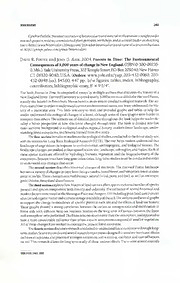
Forests in Time: The Environmental Consequences of 1,000 years of change in New England by David R. Foster, John D. Aber PDF
Preview Forests in Time: The Environmental Consequences of 1,000 years of change in New England by David R. Foster, John D. Aber
BOOKREVIEWS 2463 CynthiaPadilla,NationalinstructorofbotanicalartsandnaturalistillustrationissoughtoutJar researchprojects,reviews,conimissionedplantportraits,workshops,andasatravelleaderonsketching tours.http://www.botamcalart.50megs.com/Joinotherbotanicalartsandnaturalscienceenthusiasts at:http://groups.yahoo.com/group/botanicalart DavidR.FosterandJohnD.Aber.2004.ForestsinTime:TheEnvironmental Consequencesof1,000yearsofchangeinNewEngland.(ISBN0-30009235- 0,hbk.).YaleUniversityPress,302TempleStreet,P.O.Box209040,NewHaven CT06520-9040,U.S.A.(Orders:www.yale.edu/yup,203-432-0960,203- 432-0948fax).$45.00,447pp.,b/wfigures,tables,index,bibliography contributors,bibliographicessay,6"x91/4". Thebook,ForestsinTime,iscomposedofessaysbymultipleauthorsthatdiscussesthehistoryofa NewEnglandforest.HarvardUniversityacquirednearly3,000acrestoestablishtheHarvardForest, astudysitelocatedinPetersham,Massachusetts,asanareatoconductecologicalresearch.Theau- thorsstatedthatinordertounderstandcurrentenvironmentalissues,onemustunderstandthehis- toryofaparticulararea.Thisbookwaseasytoread,andprovidedgraphsandtablestohelpthe readerunderstandtheecologicalchangesofaforest,althoughsomeofthesegraphswereharderto interpretthanothers.Theauthorsuseofdetailedpicturesthroughoutthebookhelpsthereaderde- velopabetterperspectiveofhowthisforestchangedthroughtime.Thebookisdividedintofive mainsections:backgroundtoecologicalstudies,regionalhistory,modernforestlandscape,under- standingforestecosystems,andlessonslearnedfromthisstudy Thefirstsectionintroducesreaderstotheecologicalstudies,conductedintheforeststudysite, andthereasonsforLongTermEcologicalResearch(ITER).Thetexthelpsreadersunderstandthat landscapechangeoccursinresponsetoenvironmental,anthropogenic,andbiologicalfactors.The landscapechangesarestudiedatfourspatialscales:site,landscape,sub-region,andregion.Eachof thesespatialscalesareaffectedbyhydrology,humans,vegetation,andthebiogeochemistryofthe ecosystems.Becausetreeshavefonggenerationtimes,long-termstudiesmustbeconductedinorder tounderstandanychangesthatoccur Thesecondsectiondescribeshistoricalchangesoftheforest.TheHarvardForestlandscape hasseenavarietyofchangesintime:frombeingatundra,borealforest,andtemperateforestatsome pointinitslife.Thesechangesoccurredthroughnatural(wind,pests,andfire),aswellasanthropo- genic(NativeAmerican)disturbances. Thethirdsectionexplainshowhistoricallandusecanaffectspeciesrichness(numberofspecies present)andspeciescompositionbothdirectlyandindirectlyTheinfluenceofseveralhistoricaland modernfactorsweretestedattheMontaguePlainandProspectHillincludingpriorlandusesthatcan alterthesoilorganicmatterandnutrientstorageavailabilityofthesoil.Theauthorsusedseveralgraphs tosupportthechangeinabundanceofspecificplantsateachsiteandtheeffectsofland-usehistory Thesegraphsshowedastrongcorrelationbetweenthecarbontonitrogenratioandnitrificationin forestsoilswithdifferentland-usehistories.Studiesonthelongterminfluencesbetweentheforest andatmospherewereperformed.Theforestremovesmoreozonethantheatmosphere,andappearedto haveamoreconsiderableinfluencethanurbanareasorecosystemscomposedofsmallervegetation. Allofthesechangeshaveworkedincreatingthepresentforestecosystem. Thefourthsectiondiscussesresearchconductedtounderstandforestecosystemsthroughlong- termstudies.Scientistsconductedseveralresearchexperimentsdesignedtosimulatehurricaneaffects onforestecosystems,theprocessofnitrogensaturation,soilwarming,andlitterandrootinfluences onsoilThisresearchallowsforlongtermstudyofthesevariouseffects.Therewereseveralcontrols SIDA21(4):2463.2005 2464 BRIT.ORG/SIDA21(4) usedthroughouttheexperiments:nutrientfluctuation,"ecophysiologicalperformance,population dynamics,vegetation.structure,andecosystemproductivity" ThefifthsectionandconclusionreviewedlessonslearnedIromresearchdoneintheforest. Thisresearchisleadingtoabetterunderstandingofforestsystemsandideastoimprovelandcon- servation.Thelandandforestareconstantlychanging,andpeoplethatmanagethislandneedto "findwaystoincorjioratelandscapechangeintolongtermplanning".Thisconstantchangeproves thatinnaturalsystems,suchastheforest,longtermstudiesmustbeconductedbecausetheyhelpto developbetterconservationobjectives. Thisbookwasveryinteresting,andwillhelpreadersunderstandtheimportanceoflongterm ecologicalresearch.Thisbookwaswritteninawaythatitiseasylorthosenewtoscienceandecology tounderstand.ItisrecommendedtopersonsinterestedinNewEnglandterrestrialecologydistur- banceellectsonioreststructure,andlong-termresearchlocations.—KenMcNcw.Btndu'uulRcsccinh luslilulcojlcxai,509PfCcii}Street,l-oitWorth,rx76l(.)2-4060,U.S.A. Donc'.i.A.sE.SoiTis,Pamhi.aS.Soitls,Peti-rk.Endrh,s.s,andMarkW.Chase,2005. PhylogenyandEvolutionofAngiosperms.(ISBN0-87893-817-6,pbk.)Sinauer Associates,23PlumtrccRd,Sunderland,MA01375-0407,U.S.A.,(Orders: 413-549-1118lax;[email protected];www.sinauer.com).$59.95,370pp., numerousb&wfigures,81/2"x11". Rareisthebookthathasyoucursingitsbasictenetsandthesis,yetdrawsyoutoexploreitoften.1his issuchabook.Inmanyways,itisalreadyaclassic.Soyoumighiaswellbuyaco|iyandplaceit withineasyreachne.\ttoCronquist'sIntegratedSystem. Inessence,PhylogenyandEvolutionofAngiospermsisthemagnumopusoftheAngiosperm PhylogenyGroup(APG).Althoughtheauthors'styleissomewhatdetached,asiftoexplaintheac- tionsoftheAPGasathirdparty,theyareactuallymoversandshakersoftheAPG.Theyknowits workingsandconclusionsfromthegroundup.Althoughleadersinthefieldofangiospermmolecu- larsystematics,theyareallclassicallytrained,mostlymthe1970sandarewellversedinplantmor- phology.Thistactisevidentmthetext,andthatisthereasonformyoxymoronicrelationshipwith thisbook. Organizationolthechaptersissuchthattheyfallintothreenaturalsections.CTiapters1and2 providegeneralbackgroundandconcepts.Chapters3to9aredetailedaccountsofmolecularsup- portandmorphologicalcharacteristicsofthemajorsegmentsoftheAPCiclassification(sequenttally thebasalangiosperms,monocots,basaleudicots,peripheralcoreeudicots,caryophyllids,rosids,and asterids.Chapters10-1.3examinetheapplicationoftheAPGclassificationtoproblemsandconcepts olevolutionarydiversificationacrosstheangiosperms. Why1lovethisbook: ItisareadableandelaboratedexplanationofthecurrentAPGclassification.Besidesincorporat- ingnewpublicationstoupdateAPGII,theauthorspresentnewanalysestoanswerquestions raisedduringthecompositionofthebookitself. NotonlydotheauthorsputtheAPGcladogramintowords,buttheyalsocharacterizethemor- phologyofthetaxa(especiallyorders)recognizedintheAPGclassification.Inparticular, theyreportanysynapomorphiesthatcorroboratethemolecularlydefinedclades.Thisises- peciallyhelpfulincaseswithmorphologicallydivergenttaxathatareunitedonmolecular grounds.Theauthorsaretobecommendedlorawritingstylethatkeepsthismaterialfrom becomingtedious. SIOA21(4):2464.2005
